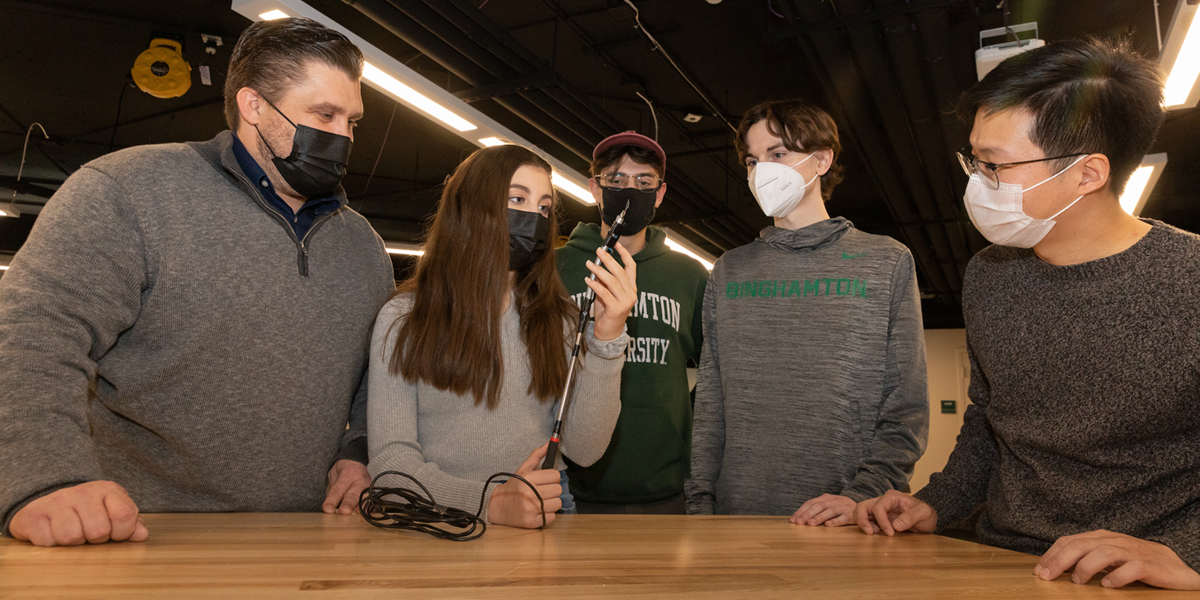Mechanical engineering students help sixth-grader develop Tick Stik
Invention with flexible camera meant to help find ticks more easily and prevent Lyme disease

Delaney Dixon, a Windsor Central School District sixth-grader, is the inventor of the Tick Stik, a device to help people find ticks on their bodies in places they can’t usually see. As part of a senior project at the Thomas J. Watson College of Engineering and Applied Science, a group of students are taking the idea and improving on it in an effort to bring the Tick Stik to market.
The team is Delaney Dixon; her father, Chris Dixon; mechanical engineering students Salvatore Mezzatesta, Jung Wok Oh and Justin Adamczak; as well as their advisor, Associate Professor Peter Huang.
“This project is different from other senior projects in the past,” Huang said. “For one, it involves community members, so this project is more like a partnership. They come to our meetings and give us suggestions, and it has had a very definitive goal from the start. It is also one of the few projects that has potential commercial worthiness, which is very exciting to the students.”
Delaney’s story begins five years ago: After playing outside all day with a friend, she checked herself for ticks as she normally would before going to bed. Usually her parents would help with this task, but as she grew older, Delaney felt more comfortable checking on her own.
The next morning, Delaney noticed a black spot under her arm. It was a deer tick, and although it had gone undetected for only a short amount of time, the damage was done.
If a tick bite goes unnoticed, a person can become infected with Lyme disease. There is not much you can do to prevent a tick bite and if you are bitten by a tick, there are few products available on the market to ensure that you are protected from tick-borne illnesses.
The lack of preventative measures and Delaney’s own experience with Lyme disease inspired the Tick Stik.
“We’re super proud,” said Chris Dixon. “We were just talking the other day how she’s one of the people now in the fight against Lyme disease — that it’s the responsibility she has.”
Delaney’s treatment for Lyme disease was a two-week course of an antibiotic, but the side effects included the loss of her fingernails and toenails, temporary dairy and gluten allergies, and other issues. She has fully recovered and designed the Tick Stik alongside her father with the intention of preventing others from going through the same experience.
The invention is an extendable and flexible wand with an HD camera on the end that transmits an image to a phone screen. It also has attachable tools for removing ticks from your body if you find them. It is designed for use by hikers, hunters, fishermen, athletes, outdoor workers and hobbyists.
The prototype of the Tick Stik was assembled from a variety of household items, and Chris Dixon used it successfully to help locate and remove a tick. Soon after, he reached out to Binghamton University, where they were encouraged to apply to have the Tick Stik become a senior project, which aims to test classroom knowledge with real-world problems.
“Collaborating with Binghamton students has been a really fun experience, something not a lot of people get to do. It was a great opportunity for me, especially since I’m only 11,” Delaney said.
The team has worked closely over the course of the school year, meeting weekly over Zoom, to further develop the device. On Feb. 11, National Inventors Day, the team held a demonstration in the Engineering Building’s Fabrication Lab.
“I chose this topic because I also had very unpleasant experiences with ticks,” Oh said. “I could definitely relate to the problem that Delaney had. I really wanted to help people in the same situation, and that has been my favorite part of working on the project.”
While the Tick Stik was Delaney’s first invention, it will not be her last.
“I’ve had a bit of engineering experience. I entered an engineering contest with my school — I was invited to do it,” she said. “The goal was to make a slingshot out of rubber bands, popsicle sticks, a spoon and some candy to throw. I ended up using the gumdrops as an epoxy to stick everything together better. I got second place with my M&M shooting 83 feet.”

